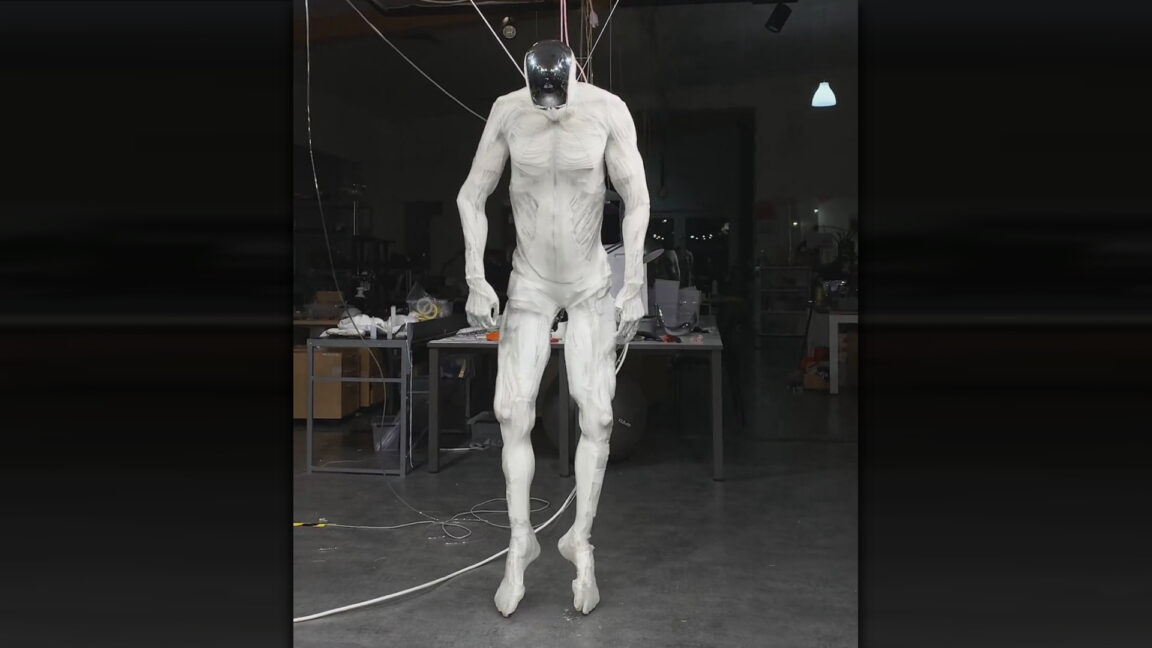Terrifying
While it seems spooky having a whole body twitching, I do appreciate the research being done.
I think we should be excited about these things. Mainly because research like this will lead to better prosthetic limbs for those who need them. We don’t need Terminators or Robomaids, but we do need more natural robotic arms and legs for those in need.
When I clicked on the video I was expecting nightmare fuel, but seemed more like …

lol fml

“Like human”
Yes, like a very, very robotic, unnatural human.
Almost like a robot.how do you know that robot is an autie??
Leave it to humans to build a robot for the purpose of lynching it.
We don’t deserve Earth.
not creepy at all… hey what’s that flash disk lying on the table
You know, it was super creepy until I got to the video without a soundtrack and found out they sound like farts.
Someone on reddit had the idea that people working on this thing are probably recording audio logs onto individual USB-sticks, which they then leave scattered all over the facility.
Ummm…. Nobody wants this. Rosie Jetson is the ideal household helper.
A 500-watt electric pump serves as the robot’s “heart,” pushing fluid at 40 standard liters per minute.
As usual, when you read the article you stumble upon a gigantic technical hurdle. 😕
EDIT: And I’m not against the technology. I’m all for prosthetics and humanoid robots for menial work.
Just imagine the possibilities if full human-pike prosthetics are developed. Think of people who have lost their arms or legs, suddenly being able to walk again.
(And of course, applied robotics for sex bots 😉)
human-pike prosthetics
Now you’re talking!
What good is a housekeeping robot if it can’t break a cavalry charge?
Now have it stand on the ground without supports.
“At long last, we have created the Torment Nexus from classic sci-fi novel Don’t Create The Torment Nexus”
Data? Is that you?

Maybe a weird aside, but what does this mean?
pushing fluid at 40 standard liters per minute.
Are there “liters” other than the 10cm x 10cm x 10cm definition?
Volume changes based on temperature and pressure. So when we reference volume measurements like for flow rates, we typically do the math to adjust those to standard temperature and pressure. Standard pressure is 1 atm but standard temperature varies based on who you’re talking to because of competing standards. It’s usually 25 C or 20 C.
When we want to reference the non temperature and pressure corrected volume, we append actual to it so that people know what the measurement is. Some people don’t do that and that causes confusion for others using their work if the reading is standard or actual.
To totally confuse you: The USA uses the “standard litre” while Europe uses “normal litre”:
Thanks, you succeeded hahaha.
From what I’m reading there this is a measure of mass flow rate of gas, expressed as volume per minute at some standard volume and pressure. Which makes some sense, you need those two parameters to be fixed so you can measure mass by volume.
And then I realized the OP article uses it for a
fluidliquid 😂Aren’t fluids and gases kinda the same thing in some aspects, just different mass? (Clearly, not a scientist).
The major difference is compressibility. Generally, liquids are practically incompressible. So just knowing the mass flow rate and density, volume flow rate can be calculated. It’s not so simple for gases
You mean the flow rate of a volume of liquid? What are you confused about exactly?
They’re asking why it’s “standard litres per minute”, instead of just “litres per minute”
Oh, well yeah Standard liters per minute or SLM, specifically refers to flow rates measured in the U.S.
So the “other” measurement would evidently be Europes “Normal liters per minute”.
What the difference is, I couldn’t tell you.







